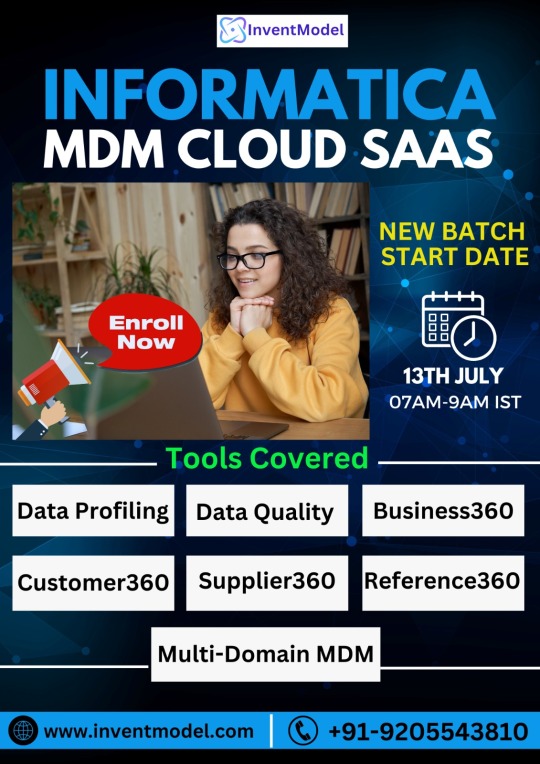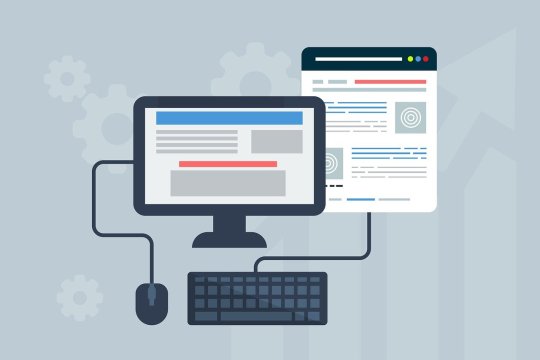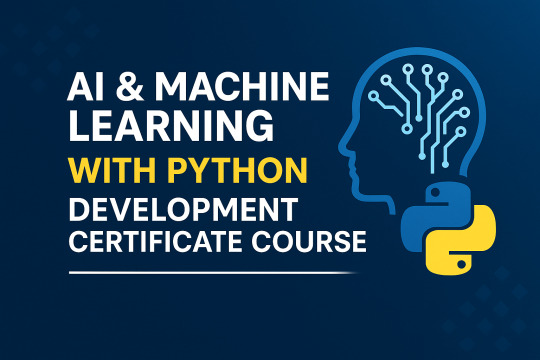#udemy open source
Explore tagged Tumblr posts
Text
How to Transition from Biotechnology to Bioinformatics: A Step-by-Step Guide

Biotechnology and bioinformatics are closely linked fields, but shifting from a wet lab environment to a computational approach requires strategic planning. Whether you are a student or a professional looking to make the transition, this guide will provide a step-by-step roadmap to help you navigate the shift from biotechnology to bioinformatics.
Why Transition from Biotechnology to Bioinformatics?
Bioinformatics is revolutionizing life sciences by integrating biological data with computational tools to uncover insights in genomics, proteomics, and drug discovery. The field offers diverse career opportunities in research, pharmaceuticals, healthcare, and AI-driven biological data analysis.
If you are skilled in laboratory techniques but wish to expand your expertise into data-driven biological research, bioinformatics is a rewarding career choice.
Step-by-Step Guide to Transition from Biotechnology to Bioinformatics
Step 1: Understand the Basics of Bioinformatics
Before making the switch, it’s crucial to gain a foundational understanding of bioinformatics. Here are key areas to explore:
Biological Databases – Learn about major databases like GenBank, UniProt, and Ensembl.
Genomics and Proteomics – Understand how computational methods analyze genes and proteins.
Sequence Analysis – Familiarize yourself with tools like BLAST, Clustal Omega, and FASTA.
🔹 Recommended Resources:
Online courses on Coursera, edX, or Khan Academy
Books like Bioinformatics for Dummies or Understanding Bioinformatics
Websites like NCBI, EMBL-EBI, and Expasy
Step 2: Develop Computational and Programming Skills
Bioinformatics heavily relies on coding and data analysis. You should start learning:
Python – Widely used in bioinformatics for data manipulation and analysis.
R – Great for statistical computing and visualization in genomics.
Linux/Unix – Basic command-line skills are essential for working with large datasets.
SQL – Useful for querying biological databases.
🔹 Recommended Online Courses:
Python for Bioinformatics (Udemy, DataCamp)
R for Genomics (HarvardX)
Linux Command Line Basics (Codecademy)
Step 3: Learn Bioinformatics Tools and Software
To become proficient in bioinformatics, you should practice using industry-standard tools:
Bioconductor – R-based tool for genomic data analysis.
Biopython – A powerful Python library for handling biological data.
GROMACS – Molecular dynamics simulation tool.
Rosetta – Protein modeling software.
🔹 How to Learn?
Join open-source projects on GitHub
Take part in hackathons or bioinformatics challenges on Kaggle
Explore free platforms like Galaxy Project for hands-on experience
Step 4: Work on Bioinformatics Projects
Practical experience is key. Start working on small projects such as:
✅ Analyzing gene sequences from NCBI databases ✅ Predicting protein structures using AlphaFold ✅ Visualizing genomic variations using R and Python
You can find datasets on:
NCBI GEO
1000 Genomes Project
TCGA (The Cancer Genome Atlas)
Create a GitHub portfolio to showcase your bioinformatics projects, as employers value practical work over theoretical knowledge.
Step 5: Gain Hands-on Experience with Internships
Many organizations and research institutes offer bioinformatics internships. Check opportunities at:
NCBI, EMBL-EBI, NIH (government research institutes)
Biotech and pharma companies (Roche, Pfizer, Illumina)
Academic research labs (Look for university-funded projects)
💡 Pro Tip: Join online bioinformatics communities like Biostars, Reddit r/bioinformatics, and SEQanswers to network and find opportunities.
Step 6: Earn a Certification or Higher Education
If you want to strengthen your credentials, consider:
🎓 Bioinformatics Certifications:
Coursera – Genomic Data Science (Johns Hopkins University)
edX – Bioinformatics MicroMasters (UMGC)
EMBO – Bioinformatics training courses
🎓 Master’s in Bioinformatics (optional but beneficial)
Top universities include Harvard, Stanford, ETH Zurich, University of Toronto
Step 7: Apply for Bioinformatics Jobs
Once you have gained enough skills and experience, start applying for bioinformatics roles such as:
Bioinformatics Analyst
Computational Biologist
Genomics Data Scientist
Machine Learning Scientist (Biotech)
💡 Where to Find Jobs?
LinkedIn, Indeed, Glassdoor
Biotech job boards (BioSpace, Science Careers)
Company career pages (Illumina, Thermo Fisher)
Final Thoughts
Transitioning from biotechnology to bioinformatics requires effort, but with the right skills and dedication, it is entirely achievable. Start with fundamental knowledge, build computational skills, and work on projects to gain practical experience.
Are you ready to make the switch? 🚀 Start today by exploring free online courses and practicing with real-world datasets!
#bioinformatics#biopractify#biotechcareers#biotechnology#biotech#aiinbiotech#machinelearning#bioinformaticstools#datascience#genomics#Biotechnology
4 notes
·
View notes
Text

Best Ways to Make Money Online
This review examines some of the top ways to earn money online, providing information on their potential, prerequisites, and suitability for various skill sets. The digital age has completely changed the way we approach work and income generation, and with so many opportunities at our fingertips, anyone with an internet connection can now make money online.
1. Freelance:
One of the most well-liked methods of earning money online is freelancing, which provides freedom and a variety of chances. Freelancers and clients from a variety of industries are connected by websites such as Upwork and Freelancer. There is probably a need for your abilities whether you are a marketing, programmer, graphic designer, or writer. Building a solid portfolio, establishing competitive prices, and upholding positive customer connections are essential for success in freelancing.
2. Market Research and Online Surveys:
One simple approach to make extra money is to take part in market research and internet surveys. Users are compensated for their thoughts on goods and services by websites like Vindale Research, Survey Junkie, and Swagbucks. Although the salary isn't very high, it's a clear and easy way to earn some extra cash in your free time.
3. Affiliate Marketing:
Promoting goods and services while receiving a commission for each sale made via your referral link is known as affiliate marketing. This approach works especially well for website owners, bloggers, and social media influencers. Numerous product options are available for promotion on platforms such as ClickBank, ShareASale, and Amazon Associates. Building a solid online presence and being aware of the needs of your audience are essential for affiliate marketing success.
4. E-commerce and Dropshipping:
For people who want to sell goods online, dropshipping or opening an e-commerce business can be quite profitable. With the help of platforms like Shopify, WooCommerce, and Etsy, business owners can easily launch online stores. Because dropshipping ships goods straight from suppliers to buyers, it eliminates the need for inventory management. Finding a niche market, using efficient marketing techniques, and providing high-quality items are essential for success in this industry.
5. Content Creation and Monetization:
Content creation on websites like YouTube, TikTok, and Instagram may be rewarding and lucrative for creative people. Sponsorships, item sales, and advertising money are examples of monetization options. It takes time and work to develop a loyal following, but those who are successful in producing interesting and distinctive content stand to gain greatly.
6. Online Tutoring and Courses:
Online tutoring and course development have emerged as lucrative revenue sources with the growth of e-learning. People can teach things they are interested in or experienced at thanks to websites like VIPKid, Teachable, and Udemy. Online education is becoming more and more popular, whether it is for professional development courses, programming, or language tutoring. Developing an organized curriculum and interesting content is essential to drawing in and keeping learners.
Conclusion:
To sum up, the finest online income-generating strategies rely on personal abilities, passions, and objectives. There are opportunities for everyone, regardless of your preference for the freedom of freelancing, the inventiveness of content creation, or the ambitious spirit of e-commerce. The internet has made it feasible for anybody to make money from their talents and interests from the comfort of their own home, even though success in these endeavors demands commitment and hard work.
Source: nexreview.com/best-ways-to-make-money-online
#make money online#make money fast#make money as an affiliate#make money with chatgpt#make money home
2 notes
·
View notes
Text
5 Arduino Courses for Beginners
Robotics, automation, and do-it-yourself electronics projects have all been transformed by Arduino, an open-source electronics platform. Entering the world of Arduino may seem intimidating to novices, but the correct course may make learning easier and more fun.
Arduino Step-by-Step: Getting Started (Udemy)
This extensive Udemy course is designed for complete novices. It provides an overview of Arduino's fundamentals, describing how the platform functions and assisting students with easy tasks like using sensors and manipulating LEDs.
Key Highlights:
thorough explanations for novices.
practical projects with practical uses.
instructions for configuring and debugging your Arduino board.
Introduction to Arduino (Coursera)
The main objective of this course is to introduce Arduino programming with the Arduino IDE. It goes over the fundamentals of circuits, programming, and connecting various parts, such as motors and sensors.
Key Highlights:
instructed by academics from universities.
access to a certificate of completion and graded assignments.
Concepts are explained in length but in a beginner-friendly manner.
Arduino for Absolute Beginners (Skillshare)
For those who want a quick introduction to Arduino, this brief project-based course is perfect. You'll discover how to configure and program your Arduino board to produce interactive projects.
Key Highlights:
teachings in bite-sized chunks for speedy learning.
simple projects for beginners, such as sound sensors and traffic light simulations.
Peer support and community conversations.
Exploring Arduino: Tools and Techniques for Engineering Wizardry (LinkedIn Learning)
This course delves deeply into Arduino programming and hardware integration, drawing inspiration from Jeremy Blum's well-known book. It is intended to provide you with the skills and resources you need to produce complex projects.
Key Highlights:
advice on creating unique circuits.
combining displays, motors, and sensors.
Code optimization and debugging best practices.
Arduino Programming and Hardware Fundamentals with Hackster (EdX)
This course, which is being offered in partnership with Hackster.io, covers the basics of Arduino hardware and programming. You may experiment with real-world applications because it is project-based.
Key Highlights:
Course materials are freely accessible (certification is optional).
extensive robotics and Internet of Things projects.
interaction with teachers and other students in the community.
Arduino is a great place to start if you want to construct a robot, make a smart home gadget, or just pick up a new skill. The aforementioned courses accommodate a variety of learning preferences and speeds, so every novice can discover the ideal fit. Select a course, acquire an Arduino starter kit, and set out on an exciting adventure into programming and electronics!
To know more, click here.
2 notes
·
View notes
Text
Master Informatica MDM Cloud SaaS: Top Online Training Courses to Boost Your Skills
To keep ahead in the fast-paced digital world of today, one must become proficient in cutting-edge technology. Informatica Master Data Management (MDM) Cloud SaaS is one such technology. This effective solution ensures data integrity, consistency, and correctness while assisting enterprises in managing their vital data assets. However, what makes mastering Informatica MDM Cloud SaaS crucial, and how can one begin? The greatest online training programs are accessible for you to choose from in order to advance your profession and improve your abilities.

What is Informatica MDM Cloud SaaS?
Informatica MDM Cloud SaaS is a cloud-based solution designed to manage and maintain an organization's master data. It integrates data from various sources, ensuring that all data is accurate, consistent, and up-to-date. Key features include data integration, data quality, and data governance. The benefits of using Informatica MDM Cloud SaaS are manifold, from improving business decision-making to enhancing customer satisfaction.
Why Master Informatica MDM Cloud SaaS?
The demand for professionals skilled in Informatica MDM Cloud SaaS is on the rise. Industries across the board require experts who can ensure their data is reliable and useful. Mastering this tool not only opens up numerous career opportunities but also enhances your personal growth by equipping you with in-demand skills.
Top Online Training Courses for Informatica MDM Cloud SaaS
When it comes to learning Informatica MDM Cloud SaaS, choosing the right course is crucial. Here, we'll explore the top online training platforms offering comprehensive and high-quality courses.
Coursera Informatica MDM Courses
Course Offerings: Coursera offers a variety of Informatica MDM courses, ranging from beginner to advanced levels.
Key Features: These courses are taught by industry experts and include hands-on projects, flexible schedules, and peer-reviewed assignments.
User Reviews: Learners appreciate the depth of content and the interactive learning experience.
Udemy Informatica MDM Courses
Course Offerings: Udemy provides a wide range of courses on Informatica MDM, each tailored to different skill levels and learning needs.
Key Features: Udemy courses are known for their affordability, lifetime access, and extensive video content.
User Reviews: Users highlight the practical approach and the quality of instruction.
LinkedIn Learning Informatica MDM Courses
Course Offerings: LinkedIn Learning features several courses on Informatica MDM, focusing on both theoretical knowledge and practical skills.
Key Features: Courses include expert-led tutorials, downloadable resources, and the ability to earn certificates.
User Reviews: Learners commend the platform's user-friendly interface and the relevance of the course material.
Edureka Informatica MDM Courses
Course Offerings: Edureka offers comprehensive Informatica MDM courses designed to provide in-depth knowledge and hands-on experience.
Key Features: Courses come with live instructor-led sessions, 24/7 support, and real-life project work.
User Reviews: Students appreciate the interactive sessions and the immediate support from instructors.
Simplilearn Informatica MDM Courses
Course Offerings: Simplilearn provides a structured learning path for Informatica MDM, including self-paced learning and instructor-led training.
Key Features: The platform offers blended learning, industry-recognized certification, and real-world projects.
User Reviews: Reviews often mention the detailed curriculum and the quality of the learning materials.
Pluralsight Informatica MDM Courses
Course Offerings: Pluralsight offers specialized courses on Informatica MDM, catering to both beginners and advanced learners.
Key Features: The platform includes skill assessments, hands-on labs, and a library of on-demand courses.
User Reviews: Users praise the comprehensive nature of the courses and the practical exercises provided.
youtube
How to Choose the Right Course for You
Choosing the right course depends on various factors such as your current skill level, learning preferences, and career goals. Consider the following when selecting a course:
Course Content: Ensure the course covers all necessary topics and offers practical exercises.
Instructor Expertise: Look for courses taught by experienced professionals.
Certification: Check if the course provides a recognized certification.
Reviews and Ratings: Read user reviews to gauge the course's effectiveness.
Tips for Succeeding in Online Informatica MDM Training
Succeeding in online training requires discipline and strategic planning. Here are some tips to help you along the way:
Time Management: Allocate specific time slots for study and stick to them.
Practice Regularly: Apply what you learn through hands-on exercises and projects.
Utilize Resources: Make use of community forums, study groups, and additional learning resources.
Certification and Beyond
Earning a certification in Informatica MDM Cloud SaaS is a significant achievement. It validates your skills and can open doors to advanced career opportunities. Here are the steps to get certified:
Choose a Certification: Select a certification that aligns with your career goals.
Prepare Thoroughly: Utilize online courses, study guides, and practice exams.
Schedule the Exam: Register for the certification exam and choose a convenient date.
Pass the Exam: Apply your knowledge and pass the exam to earn your certification.
Case Studies of Successful Informatica MDM Professionals
Real-world examples can be highly motivating. Here are a few case studies of professionals who have successfully mastered Informatica MDM and advanced their careers:
Case Study 1: John Doe, a data analyst, leveraged his Informatica MDM skills to become a data manager at a leading tech firm.
Case Study 2: Jane Smith transitioned from a junior IT role to a senior data governance position after completing an Informatica MDM certification.
FAQs
What is the best course for beginners? The best course for beginners typically includes a comprehensive introduction to Informatica MDM, such as those offered on Coursera or Udemy.
How long does it take to master Informatica MDM Cloud SaaS? The time required varies based on individual pace and prior experience, but typically ranges from a few months to a year.
Is certification necessary to get a job? While not always mandatory, certification significantly boosts your job prospects and credibility.
Can I learn Informatica MDM Cloud SaaS without a technical background? Yes, many courses are designed for beginners and provide the foundational knowledge needed to understand and use Informatica MDM Cloud SaaS.
What are the costs associated with these courses? Course costs vary by platform and course level, ranging from free options to several hundred dollars for more advanced and comprehensive training.
Conclusion
Mastering Informatica MDM Cloud SaaS can significantly enhance your career prospects and professional growth. With the right training and dedication, you can become an expert in managing critical data assets. Start your learning journey today by choosing a course that fits your needs and goals.
I hope you are having a wonderful day! I have a
#informatica MDM#Informaticatraining#informaticamdmcloudsaastraining#informatica#informaticatraining#Youtube
3 notes
·
View notes
Text
Best of Web Development Courses: A Comprehensive Guide

Web development is a vital skill in today’s digital world. Whether you're aspiring to become a professional web developer or looking to enhance your skills, selecting the right web development course is crucial. With countless options available, it can be overwhelming to know where to start. This article provides a guide to the best web development courses available, helping you navigate through the top choices and find the one that suits your needs.
Why Take a Web Development Course?
Web development encompasses everything from creating basic websites to complex applications. The demand for skilled web developers is consistently high as businesses transition to digital platforms. By taking a web development course, you can:
Enhance your coding skills: Learn programming languages like HTML, CSS, JavaScript, and more.
Gain practical experience: Hands-on projects help you build a portfolio to showcase your skills.
Stay updated with industry trends: Modern courses keep you informed on the latest technologies and best practices.
Open career opportunities: Web development is a versatile field with various career paths such as front-end, back-end, or full-stack development.
Now, let’s dive into the top 10 web development courses that will give you the edge you need.
Top 10 Web Development Courses
The Web Developer Bootcamp – UdemyOverview: This course, created by Colt Steele, is one of the most popular web development bootcamps available. It covers everything from HTML, CSS, and JavaScript to more advanced topics like Node.js and Express.Why it stands out:
Over 63 hours of content.
Project-based learning with real-world applications.
Affordable pricing with regular discounts.
Ideal for: Beginners looking to get an in-depth introduction to web development.
Full-Stack Web Development with React – Coursera (offered by Hong Kong University of Science and Technology)Overview: This course focuses on the MERN stack (MongoDB, Express, React, Node). It's offered through Coursera by the Hong Kong University of Science and Technology, which gives it a reputable edge.Why it stands out:
Covers both front-end (React) and back-end development.
Offers a certificate from a prestigious institution.
Focuses on responsive web design.
Ideal for: Learners who want to focus on full-stack web development.
The Odin ProjectOverview: The Odin Project is a free, open-source curriculum that takes you through the entire web development process. It focuses on Ruby on Rails, JavaScript, and offers plenty of hands-on projects.Why it stands out:
Completely free with a community of learners.
Comprehensive learning paths from beginner to advanced.
Emphasizes practical projects.
Ideal for: Self-motivated learners looking for a free, community-driven option.
CS50’s Web Programming with Python and JavaScript – edX (Harvard University)Overview: CS50 is Harvard’s famous computer science course, and this specific track focuses on web programming. You’ll learn about Python, Django, JavaScript, and SQL through this rigorous program.Why it stands out:
Offered by Harvard University.
Covers complex web development topics such as Django and security.
Highly challenging, suitable for intermediate to advanced learners.
Ideal for: Developers with some background looking to dive deeper into web programming.
Complete Web Development Bootcamp – Udemy (Dr. Angela Yu)Overview: Dr. Angela Yu’s bootcamp is highly rated on Udemy for its engaging teaching style and comprehensive approach. You’ll learn HTML, CSS, JavaScript, Node.js, React, and even a little bit of web design.Why it stands out:
Over 55 hours of content.
Fun and engaging style with a focus on building projects.
Regularly updated to reflect the latest technologies.
Ideal for: Beginners who want to build a solid foundation in web development.
Responsive Web Design – freeCodeCampOverview: FreeCodeCamp is known for offering free, self-paced coding lessons, and its Responsive Web Design certification is one of the most popular. You’ll learn HTML5, CSS3, and responsive design principles.Why it stands out:
Free and self-paced.
300 hours of content including hands-on projects.
Community support and real-world project building.
Ideal for: Those looking for a free, structured way to learn responsive web design.
Zero to Mastery Complete Web Developer – Udemy (Andrei Neagoie)Overview: Andrei Neagoie’s course takes a hands-on approach to web development, covering everything from HTML and CSS to advanced topics like React and Node.js.Why it stands out:
Covers both front-end and back-end development.
Real-world projects like building a chat application.
Regularly updated to reflect industry changes.
Ideal for: Beginners to intermediate learners looking for comprehensive training.
Modern React with Redux – Udemy (Stephen Grider)Overview: React is one of the most in-demand front-end technologies today, and Stephen Grider’s course is perfect for those looking to specialize in it. This course covers React and Redux, focusing on building dynamic web applications.Why it stands out:
Specialized focus on React and Redux.
Project-based learning.
Great for intermediate learners.
Ideal for: Developers looking to specialize in React.
Learn Web Development – Mozilla Developer NetworkOverview: MDN’s web development course is a comprehensive, free resource that covers all aspects of web development. It’s created by the Mozilla Developer Network, known for its high-quality documentation.Why it stands out:
Free and constantly updated.
Covers the basics to advanced topics.
Reliable and well-documented resources.
Ideal for: Learners who prefer self-paced study with extensive documentation.
JavaScript, HTML, and CSS for Web Developers – Coursera (Johns Hopkins University)
Overview: This course, offered through Coursera by Johns Hopkins University, focuses on the fundamentals of JavaScript, HTML, and CSS, which are essential building blocks for any web developer.
Why it stands out:
Covers core web technologies.
Earn a certificate from a well-known university.
Focus on building real-world projects.
Ideal for: Beginners looking to get certified in web development fundamentals.
What to Look for in a Web Development Course
When choosing the best web development course for your needs, consider the following:
Skill Level: Are you a beginner or do you have some coding experience? Courses like The Odin Project and freeCodeCamp are great for beginners, while more advanced developers might prefer CS50’s Web Programming or Modern React with Redux.
Specialization: Do you want to focus on front-end (HTML, CSS, JavaScript), back-end (Node.js, Django), or full-stack development? Choose a course based on your career goals.
Project-Based Learning: A good web development course should include hands-on projects to help you apply what you've learned. The more projects, the better your portfolio will look to potential employers.
Certification: If you’re looking for recognition, consider courses that offer certificates from reputable institutions, like those from Coursera or edX.
Price: While some courses are free, others may require a one-time fee or subscription. Many platforms like Udemy offer discounts, so be sure to check regularly.
Final Thoughts
Whether you're just starting your journey in web development or looking to advance your skills, there’s a course out there for you. The best web development courses offer a blend of hands-on projects, updated content, and engaging instruction. As you consider the top 10 web development courses, think about your current skill level, your career aspirations, and your learning preferences. With the right course, you’ll be well on your way to becoming a proficient web developer.
Remember, learning web development is a marathon, not a sprint. Choose a course that fits your pace, stay consistent, and you'll see significant improvement in no time!
2 notes
·
View notes
Text
java full stack
A Java Full Stack Developer is proficient in both front-end and back-end development, using Java for server-side (backend) programming. Here's a comprehensive guide to becoming a Java Full Stack Developer:
1. Core Java
Fundamentals: Object-Oriented Programming, Data Types, Variables, Arrays, Operators, Control Statements.
Advanced Topics: Exception Handling, Collections Framework, Streams, Lambda Expressions, Multithreading.
2. Front-End Development
HTML: Structure of web pages, Semantic HTML.
CSS: Styling, Flexbox, Grid, Responsive Design.
JavaScript: ES6+, DOM Manipulation, Fetch API, Event Handling.
Frameworks/Libraries:
React: Components, State, Props, Hooks, Context API, Router.
Angular: Modules, Components, Services, Directives, Dependency Injection.
Vue.js: Directives, Components, Vue Router, Vuex for state management.
3. Back-End Development
Java Frameworks:
Spring: Core, Boot, MVC, Data JPA, Security, Rest.
Hibernate: ORM (Object-Relational Mapping) framework.
Building REST APIs: Using Spring Boot to build scalable and maintainable REST APIs.
4. Database Management
SQL Databases: MySQL, PostgreSQL (CRUD operations, Joins, Indexing).
NoSQL Databases: MongoDB (CRUD operations, Aggregation).
5. Version Control/Git
Basic Git commands: clone, pull, push, commit, branch, merge.
Platforms: GitHub, GitLab, Bitbucket.
6. Build Tools
Maven: Dependency management, Project building.
Gradle: Advanced build tool with Groovy-based DSL.
7. Testing
Unit Testing: JUnit, Mockito.
Integration Testing: Using Spring Test.
8. DevOps (Optional but beneficial)
Containerization: Docker (Creating, managing containers).
CI/CD: Jenkins, GitHub Actions.
Cloud Services: AWS, Azure (Basics of deployment).
9. Soft Skills
Problem-Solving: Algorithms and Data Structures.
Communication: Working in teams, Agile/Scrum methodologies.
Project Management: Basic understanding of managing projects and tasks.
Learning Path
Start with Core Java: Master the basics before moving to advanced concepts.
Learn Front-End Basics: HTML, CSS, JavaScript.
Move to Frameworks: Choose one front-end framework (React/Angular/Vue.js).
Back-End Development: Dive into Spring and Hibernate.
Database Knowledge: Learn both SQL and NoSQL databases.
Version Control: Get comfortable with Git.
Testing and DevOps: Understand the basics of testing and deployment.
Resources
Books:
Effective Java by Joshua Bloch.
Java: The Complete Reference by Herbert Schildt.
Head First Java by Kathy Sierra & Bert Bates.
Online Courses:
Coursera, Udemy, Pluralsight (Java, Spring, React/Angular/Vue.js).
FreeCodeCamp, Codecademy (HTML, CSS, JavaScript).
Documentation:
Official documentation for Java, Spring, React, Angular, and Vue.js.
Community and Practice
GitHub: Explore open-source projects.
Stack Overflow: Participate in discussions and problem-solving.
Coding Challenges: LeetCode, HackerRank, CodeWars for practice.
By mastering these areas, you'll be well-equipped to handle the diverse responsibilities of a Java Full Stack Developer.
visit https://www.izeoninnovative.com/izeon/
2 notes
·
View notes
Text
Fulfill Your Dreams: How to Earn from Home Successfully

In 2024, the internet has opened up numerous opportunities for individuals to earn a substantial income from the comfort of their homes. With a wide range of online jobs available, it is now possible to pursue a lucrative career by mastering a job that aligns with your interests and expertise. The flexibility and convenience of working remotely enable you to earn a significant income while enjoying the comfort and convenience of your home.
It is essential to recognize that most methods of earning money online necessitate dedication, perseverance, and a patient approach. While the internet offers numerous opportunities to generate income, it typically takes time and effort to achieve meaningful results. Building a successful online venture or establishing a steady stream of online income often requires consistent work, learning, and adapting to the evolving digital landscape.
However, here are some ways you can make money online relatively quickly:
1. Affiliate Marketing: Affiliate marketing is promoting other people's products and earning a commission on each sale. You can start by creating a blog or a YouTube channel, and promote products related to your niche.
2. Freelance Work: If you have skills like writing, graphic designing, web development, or any other skill that can be offered as a service, then you can start freelancing on various online platforms. You can create a profile on websites like Upwork, Fiverr, Freelancer, and start getting clients from all around the world.
3. Online Teaching: If you have expertise in any subject, you can teach it online. You can offer classes on websites like Udemy, Skillshare, or Teachable. You can also offer personalized coaching or tutoring services.
4. Sell digital products: If you have skills like graphic design, programming, or writing, you can create and sell digital products like e-books, stock photos, or website templates on websites like Gumroad or Creative Market.
5. Dropshipping: Dropshipping is an e-commerce model where you don't have to maintain an inventory. You can create an online store, and when someone orders a product, you purchase it from a supplier who ships the product directly to the customer.
6. Online transcription: Some companies pay people to transcribe audio or video files into written documents. You can find transcription opportunities on websites like Rev or TranscribeMe.
7. Online Surveys: There are many websites that pay for completing online surveys. Though the pay is not very high, it can be a good source of side income. Some popular survey sites are Swagbucks, Survey Junkie, and Vindale Research.
Also, you can start your work in the freelance sector. If you learn any high-demand skill like Graphic Design- Digital Marketing-Video Editing so, you can earn huge money from that type of work.
Here you will find one of your most choice-full platforms where you can start your online Job from home.
Top 5 freelancing platforms:
1. Upwork
2. Freelancer
3. Fiverr
4. Guru
5. PeoplePerHour
Note that these are some ideas to start now, and your success in making money from home depends on various factors such as your skills, experience, dedication, and market demand. Hope you understand all and it will be helpful for you. Have a Nice journey.
#make money online#online business#freelancing#digital marketing#socialmediamarketing#affiliatemarketing#work from home
2 notes
·
View notes
Text
Path to Selenium Mastery: Your Comprehensive Guide to Automated Testing
In today's dynamic digital landscape, ensuring the quality and reliability of web applications is paramount. Enter Selenium, the premier automation testing framework that has transformed the way web applications are tested. Whether you're a seasoned QA engineer or a budding tester aiming to elevate your skills, mastering Selenium unlocks a myriad of opportunities in automated testing.

This comprehensive guide is your roadmap to mastering Selenium and advancing your testing expertise.
Foundations of Selenium Mastery
Embarking on your Selenium journey requires a strong understanding of its fundamentals and automated testing principles. Start by familiarizing yourself with the core concepts of Selenium, including the Selenium WebDriver and its architecture, and how it interacts with web browsers to automate testing tasks. This foundational knowledge sets the stage for your Selenium proficiency.
Selecting Learning Resources
Choose reliable and comprehensive learning resources to support your Selenium learning journey. With a multitude of online tutorials, courses, and documentation available, platforms like Udemy, Coursera, and Pluralsight offer tailored courses catering to various skill levels. Find resources that resonate with your learning style and preferences to maximize your learning experience.
Hands-on Learning Experience
Practice is paramount when it comes to mastering Selenium. Dive into hands-on practice by setting up your development environment, downloading the Selenium WebDriver, and crafting test scripts in your preferred programming language, whether it's Java, Python, or JavaScript. Through practical exercises, you'll deepen your understanding of Selenium's capabilities and functionalities.
Building Practical Projects
Apply your newfound knowledge by undertaking small-scale Selenium projects. Start with simple tasks like automating form submissions or navigating web pages, gradually progressing to more complex scenarios. Building projects not only reinforces your Selenium skills but also enhances your problem-solving abilities and boosts your confidence as a tester.

Exploring Advanced Techniques
Advance your Selenium expertise by delving into advanced topics and techniques. Learn how to handle dynamic elements, work with frames and iframes, implement synchronization strategies, and integrate Selenium with popular testing frameworks like TestNG or JUnit. Mastering these advanced concepts equips you to tackle real-world testing challenges with ease.
Community Engagement
Joining Selenium-centric online communities and forums provides invaluable support and insights. Platforms like the Selenium WebDriver Google Group or the Selenium subreddit offer opportunities to connect with peers, seek advice, and share experiences. Engaging with the community fosters collaboration and accelerates your learning journey.
Enrolling in Online Courses
Enroll in online courses offered by reputable platforms to gain structured learning paths and expert guidance. Courses on platforms like Udemy, Coursera, or Pluralsight offer hands-on exercises, real-world examples, and practical insights from industry professionals. Continuous learning through online courses ensures you stay updated with the latest trends and advancements in automated testing.
Practical Application
Apply your Selenium skills to real-world testing scenarios by contributing to open-source projects or collaborating with local businesses. This practical experience not only enhances your skills but also strengthens your resume, making you a competitive candidate in the job market. Real-world application solidifies your understanding and prepares you for future challenges.
Staying Informed
The field of automated testing is ever-evolving, with new tools and techniques emerging regularly. Stay informed by following industry blogs, attending webinars, and participating in online conferences. Keeping abreast of the latest developments ensures you remain at the forefront of the industry and positions you as a trusted expert in Selenium testing.
Continual Growth
Remember, learning Selenium is a journey, not a destination. Challenge yourself to explore new features, experiment with different approaches, and expand your knowledge base. Mastery requires dedication and persistence, so embrace opportunities for growth and development along the way.
In conclusion, mastering Selenium is an enriching journey that requires commitment, practice, and continuous learning. By following this comprehensive guide and embracing hands-on practice, community engagement, and ongoing education, you'll navigate the path to Selenium mastery and unlock endless possibilities in automated testing. So, dive in, embark on your Selenium journey, and embark on a rewarding career in software testing. Happy testing!
2 notes
·
View notes
Text
Project Driven Learning - Dumped in notion today's morning😅
Vision
[ ] Job But in a good organization that I can be proud of
[ ] Worked for interesting companies at the beginning of my career which are also easier to get into and can provide valuable experience and a learning environment
[ ] I want to build visionary solutions for an organization like Sundar Pichai did for Google.
Projects
[ ] Meaningful projects - projects that I want to use myself
[ ] Find clone development projects of popular apps
[ ] I'll just have to build Just good enough projects
[ ] Project Matrix - Value / Complexity / Skills / Scope
[ ] Projects that are not just learning coding and development but also cloud computing and other skills
[ ] Don’t just build what you are passionate about but build what resonates with the target audience for which you are going to be applying for
[ ] What’s the enterprise-level business problem for which a solution can be coded equivalent to the exercises I’ve done from the book
[ ] Enterprise level Solving some Business Problems
System
[ ] Build the developer's Brain
[ ] Setting up a system to efficiently complete projects after projects
[ ] Build using AI and Google → Do the same projects using tutorials → Build a similar project of my own on my own
[ ] Keep reflecting to improve the project system and workflow
[ ] What are the outcomes of working on that project?
[ ] Pivot when projects not working or when gotten stuck
[ ] Which projects to take
[ ] Each project must have Skill/ challenge/ value/ purpose criteria
[ ] aligned with your immediate goals, if not add to the project backlog
[ ] Create mini frameworks to build project-efficient, effective and robust solutions.
[ ] Learn from the experts - So many online have built projects with so many functional things
[ ] How they approach building a new project
[ ] How they plan to Strategically set up for success
[ ] How they start a project from scratch
[ ] How do they plan architecture?
[ ] Build a project-building system and improve it along the way while building and learning
Resources
[ ] Theory management by reflecting on the progress of the project
[ ] Cross-check the concepts learnt in the theory
[ ] Find books & courses with enterprise-level application project
[ ] Full in-depth tutorials with examples
[ ] Reverse engineer Portfolios and Github
[ ] Research the expert people in building projects.
[ ] Medium, Github contributors
[ ] Udemy SDE project tutorials
[ ] Workshop → Software Development
[ ] Job boards require analysis to practice skills for software engineering
[ ] Agile certification
[ ] Cloud Certification
[ ] Software development online communities to ask for help and feedback and get to know about new things
High-Quality Questions
[ ] How to become a GitHub star
[ ] How to become an open-source star
[ ] what it takes to create a software from scratch till deployment
[ ] How to become a modern software engineer
[ ] What are the skills apart from coding and development?
[ ] What skills to acquire to go from to great engineer
Profession
[ ] Gather a network of support system
To help out of the stuck zone
Get feedback on stuck projects
[ ] Find a few developer friends
[ ] Ask them if they have built projects and hosted them on GitHub
[ ] Ask them to give feedback on my progress & help me make it functional
[ ] Software development online communities to get to know about new things
2 notes
·
View notes
Text
youtube
Looking to boost your income without spending a dime? You're in the right place. In this video, we'll dive into The Top 12 Ways to Earn Money Online without any upfront investment.
Whether you are a student, a stay-at-home parent, or a busy professional, you can find something that suits your skills and schedule. You don’t need any special qualifications or experience to start making money online.
All you need is a computer, an internet connection, and a willingness to learn.Hit that subscribe button and join a financial freedom journey with us.
#1. Freelancing:
Freelancing, the gateway to earning money online without upfront investment, is a realm of possibilities. It empowers individuals to capitalise on their skills, offering services across various domains like writing, design, coding, and more.
Platforms like Upwork, and Fiver, connect freelancers with a global client base, fostering autonomy in choosing projects and clients. Success requires dedication, quality work, and continuous improvement.
Freelancing not only generates income but also builds a diverse portfolio and opens doors to remote work opportunities. The journey might be competitive, but the rewards are substantial for those who embrace the freelancing world with determination.
#2. Content Creation:
Content creation stands as a vibrant avenue for online earnings without initial investment. Crafted with passion, blogs, videos, and podcasts can become lucrative sources of income.
Through ad revenue, sponsorships, and merchandise, creators monetize their platforms. Building a dedicated audience takes time, but quality and consistency pay off. This creative journey allows individuals to share expertise, stories, and insights while generating income.
Whether you're a budding writer, vlogger, or podcaster, the online world provides an audience eager to engage with compelling content and contribute to your financial success.
#3. Online Surveys & Market Research:
Participating in online surveys and market research is a straightforward method to earn money from home, sans investment.
Platforms like Swagbucks and Survey Junkie offer opportunities to share opinions on products and services in exchange for rewards or cash. While not a primary income source, it's a convenient way to earn extra money during leisure time.
Stay cautious of scams and opt for reputable survey platforms to ensure a genuine experience. By dedicating a bit of your time, you can contribute to market research while enjoying a modest supplementary income.
#4. Online Tutoring or Teaching:
Online tutoring and teaching open doors to online income generation without upfront costs. Platforms like VIPKid and Udemy enable individuals to share their expertise globally.
Creating and selling online courses on various subjects can yield passive income over time. Teaching languages, skills, or academic subjects offers both financial rewards and personal fulfilment.
As the digital education landscape continues to expand, this avenue empowers educators and experts to reach learners worldwide, while also contributing to their own income and professional growth.
#5. Remote Work:
Remote work provides a genuine opportunity to earn money online without requiring an initial investment. Platforms like Remote.co and FlexJobs curate a range of remote job options across diverse industries and skill sets.
These jobs offer flexibility in terms of location and working hours, making them suitable for those aiming to achieve a better work-life balance.
From customer service to writing, programming, and design, remote work allows individuals to leverage their expertise while enjoying the benefits of working from home or any location with an internet connection.
#6. Affiliate Marketing:
Affiliate marketing is an exciting avenue to earn money online without any upfront investment. By promoting products or services through personalized referral links, individuals can earn commissions for each successful sale.
Partnering with companies like Amazon or affiliate networks allows for flexible integration into blogs, social media, or websites. While building a substantial income may take time, strategic affiliate marketing can provide a passive revenue stream that grows with your online presence.
It's essential to understand your audience, select relevant products, and create engaging content that encourages conversions. With dedication and the right approach, affiliate marketing can be a rewarding online income source.
#7. Online Marketplaces:
Online marketplaces offer an accessible route to earning money without initial investment. Platforms like Etsy, eBay, and Amazon enable users to sell products, crafts, and items they no longer need.
Though there might be listing or selling fees, these are generally minimal. Creating compelling listings and providing excellent customer service are key to success. These marketplaces provide exposure to a vast online audience, allowing sellers to turn their hobbies and creations into a source of income.
It's important to research the platform's policies, optimize your listings, and maintain professionalism to maximize your earnings and reputation within the online marketplace community.
#8. Online Writing & Content Creation:
Online writing and content creation platforms offer a gateway to earn money while sharing expertise and insights. Websites like Medium, HubPages, and Vocal provide opportunities to publish articles on various topics.
Depending on the platform, you can earn through ad revenue, reader engagement, or upfront payments. This approach doesn't require an initial investment and allows aspiring writers to showcase their talents, grow their audience, and generate income through their written content.
Consistency, quality, and understanding your target audience are crucial for building a successful online writing venture. With dedication, your writing journey can lead to both personal satisfaction and financial rewards.
#9. Microtasks:
Engaging in microtasks on platforms like Amazon Mechanical Turk and Clickworker can be a way to earn small amounts of money online without any upfront investment.
These tasks may include data entry, image categorization, transcription, and more. While the pay for each task is usually low, they offer a flexible option to earn extra income in your spare time. It's important to approach microtasking with efficiency and attention to detail to maximize your earnings.
While it might not provide substantial income, microtasking can be a convenient and accessible way to supplement your finances with minimal commitment.
#10. Gig Economy Platforms:
Gig economy platforms like TaskRabbit provide a practical way to earn money online without upfront investment. Offering services such as errand running, household chores, or personal assistance to local clients can be both fulfilling and profitable.
By listing your services and rates on platforms like TaskRabbit, you tap into a network of people seeking help with various tasks. Building a positive reputation through quality service can lead to repeat clients and referrals, creating a steady income stream.
This avenue offers the flexibility to choose the tasks you're comfortable with and the convenience of remote or local work, making it an attractive option for those looking to earn money online without a significant commitment.
#11 Online Transcription:
Online transcription is a viable way to earn money without an initial investment. If you're adept at typing and attentive to detail, platforms like TranscribeMe and Rev offer opportunities to transcribe audio and video content.
Your earnings can vary based on the complexity and volume of tasks you complete. This method suits individuals who have good listening skills and are comfortable transcribing various types of content, from interviews to podcasts, all from the comfort of your home.
#12 Virtual Assistance:
Becoming a virtual assistant presents a flexible online earning avenue. Businesses and entrepreneurs seek assistance with tasks like email management, scheduling, and social media.
Platforms like Time Etc facilitate connections between virtual assistants and clients. Your organisational skills and multitasking ability are assets in this role. By offering reliable support remotely, you can earn money while helping others streamline their operations.
This method offers both financial rewards and the satisfaction of contributing to others' success, all without an upfront investment.
As we conclude our exploration of the 10 best ways to earn money online without any investment, remember that success in the online realm requires dedication and perseverance.
Prioritize your strengths and skills when choosing a path, and always research thoroughly to avoid scams. Leverage the power of freelancing, content creation, and online tutoring to build a sustainable income stream.
Engaging in online surveys and microtasks can supplement your earnings, while affiliate marketing and remote work offer exciting possibilities. When selling on online marketplaces, focus on quality, pricing, and customer satisfaction.
For the best outcomes, maintain consistency and commitment. Now, I invite you to take action! If you found these insights helpful, don't forget to hit the like button and subscribe to our channel for more valuable content.
Have you tried any of these methods?
Share your experiences and tips in the comments below. Your insights might just help someone kickstart their online earning journey. And if you think this information could benefit others, don't hesitate to hit the share button.
Thanks for watching, and let's all achieve our financial goals together in the dynamic world of online opportunities!"
#earn money online 2023#earn money online app#earn money online without investment#make money fast#make money today#how to earn money#make money online#make money from home#Youtube
4 notes
·
View notes
Text
3d product renderings and mockups

It seems like you're looking for information or assistance with 3D product renderings and mockups. Creating 3D product renderings and mockups is a crucial step in the design and marketing process for various industries. Here's some information to help you get started:
1. Software for 3D Rendering:
Blender: A powerful and free open-source 3D creation suite.
Autodesk Maya: Widely used in the film and video game industry.
Cinema 4D: Known for its intuitive interface and powerful capabilities.
KeyShot: A standalone 3D rendering and animation application.
2. Creating 3D Models:
CAD Software (Computer-Aided Design): Use software like AutoCAD, SolidWorks, or Rhino to create accurate 3D models.
Sculpting Software: Tools like ZBrush or Blender's sculpting features are great for organic shapes.
3. Texturing and Materials:
Apply realistic textures and materials to your 3D model using UV mapping techniques.
Software like Substance Painter or Quixel Mixer can help create detailed and realistic materials.
4. Lighting:
Proper lighting is crucial for realistic renders. Experiment with different light setups to achieve the desired look.
Consider using High Dynamic Range Imaging (HDRI) for realistic environmental lighting.
5. Rendering:
Choose the appropriate rendering engine for your needs (Cycles in Blender, Arnold, V-Ray, etc.).
Adjust rendering settings such as resolution, quality, and output format.
6. Mockup Tools:
Adobe Dimension: Allows you to create realistic 3D mockups and product visualizations.
Placeit: An online platform that lets you create mockups with your designs on various products.
Mockup World: Offers a variety of free and premium mockups for different products.
7. Tutorials and Learning Resources:
Online platforms like Udemy, Coursera, and YouTube offer tutorials on 3D modeling, rendering, and mockup creation.
Join forums and communities like Blender Artists or Polycount for support and feedback.
8. Considerations for Product Mockups:
Understand the target audience and purpose of the mockup.
Pay attention to lighting, shadows, and reflections to make the mockup realistic.
Test the mockup on different backgrounds to ensure versatility.
9. Outsourcing:
If creating 3D models and renders is outside your expertise, consider outsourcing to professional 3D artists or agencies.
Remember to practice and experiment with different techniques to refine your skills. The field of 3D rendering is vast, and continuous learning is key to staying updated with the latest trends and technologies.




#shirts#shirt design#artist shirts#tees#tshirts#toby's beans#coffee cat#sundew farms#sunflower fox#sugarbritches#apple orchard#vintage logos#logo design#shop#merch#countrycore#farmcore#cottagecore#fashion#my art#horror#slashers#graphic design#the conjuring#the conjuring 3#the conjuring: the devil made me do it#scream#scream 1996#a nightmare on elm street#anoes
2 notes
·
View notes
Text
Offer Tips And Guidance For Aspiring Web Developers

Web Development Career Advice: Offer tips and guidance for aspiring web developers, including learning resources, career paths, and job market insights.
Web development is an exciting and dynamic field that offers countless opportunities for aspiring developers. Whether you’re just starting your journey or looking to advance your career, this article provides valuable advice and guidance to help you thrive in the world of web development.
1. Learn Continuously
Web development is constantly evolving, with new technologies, frameworks, and best practices emerging regularly. To stay relevant and competitive, it’s essential to commit to lifelong learning. Here are some tips:
Online Courses: Platforms like Udemy, Coursera, edX, and Codecademy offer a wide range of web development courses, from beginner to advanced levels.
Documentation and Tutorials: Read documentation and follow tutorials for the technologies you’re interested in. Official documentation is a valuable resource.
Books: Invest in web development books that cover fundamental concepts and provide in-depth knowledge on specific topics.
Online Communities: Join developer forums, participate in discussions, and ask for help when needed. Sites like Stack Overflow and GitHub are great places to start.
2. Choose Your Path
Web development offers various career paths. To determine which one aligns with your interests and goals, consider the following options:
Frontend Developer: Focuses on the visual aspects of websites, including HTML, CSS, and JavaScript.
Backend Developer: Works on server-side development, handling databases, servers, and business logic.
Full-Stack Developer: Manages both frontend and backend, offering a comprehensive understanding of web development.
Specialized Roles: Consider roles like mobile app development, DevOps, or UI/UX design, which require specific skills.
3. Build a Strong Portfolio
A portfolio is your professional identity. It showcases your skills, projects, and capabilities to potential employers or clients. Here’s how to create an impressive portfolio:
Include Diverse Projects: Showcase a variety of projects that highlight your versatility and expertise.
Keep It Updated: Regularly add new projects and skills to your portfolio.
Detail Your Process: Explain the problem, solution, and technologies used in each project.
Share Your Code: Provide links to GitHub or other version control repositories to demonstrate your coding skills.
4. Gain Practical Experience
While learning theory is essential, practical experience is equally crucial. Here’s how to gain hands-on experience:
Freelance Work: Take on freelance projects to apply your skills in real-world scenarios.
Open Source Contributions: Contribute to open-source projects to collaborate with experienced developers and improve your skills.
Internships: Internships provide valuable industry experience and the chance to learn from professionals.
5. Networking
Building a strong professional network can open doors to job opportunities and collaborations. Here’s how to network effectively:
Attend Meetups and Conferences: Participate in web development events to meet like-minded individuals.
Online Communities: Join forums, Slack groups, and social media channels dedicated to web development.
LinkedIn: Create a professional LinkedIn profile to connect with industry peers and potential employers.
6. Stay Informed About the Job Market
Web development job trends can vary by region and industry. Stay informed about the job market by:
Research: Explore job postings on various job boards to understand employer expectations and trends in your area.
Consult Industry Reports: Industry reports and surveys provide insights into in-demand skills and salary trends.
7. Soft Skills Are Important
In addition to technical skills, soft skills like problem-solving, communication, and teamwork are highly valued by employers. Cultivate these skills to become a well-rounded developer.
Conclusion: Your Journey to Web Development Success
Web development is a dynamic and rewarding field, offering opportunities for those with passion and determination. By continuously learning, building a strong portfolio, gaining practical experience, networking, and staying informed about the job market, you can embark on a successful web development career.
Remember that success in web development requires commitment and persistence. Keep learning, adapt to changes, and stay passionate about creating innovative web solutions. With dedication, you can thrive in this exciting and ever-evolving industry.
Source:
#kushitworld#saharanpur#india#itcompany#seo#seo services#webdevelopment#digitalmarketing#websitedesigning
3 notes
·
View notes
Text
Mastering Self-Taught 3D Modeling: A Comprehensive Guide
Learning 3D modeling independently can be an immensely rewarding endeavor. Below, you'll find a step-by-step guide to embark on this creative journey successfully:
Define Your Objectives: Begin by clarifying your reasons for learning 3D modeling. Are you interested in game design, animation, architecture, or another specific application? Establishing clear goals will help you stay motivated and focused.
Select Suitable Software: Numerous 3D modeling software options are available, ranging from free to paid. Popular choices include Blender (free and open-source), Autodesk Maya, 3ds Max, Cinema 4D, and ZBrush. Choose software that aligns with your goals and budget.
Grasp the Basics: Start with the fundamentals. Familiarize yourself with the software's user interface, navigation, and basic tools. Most software packages offer introductory tutorials and documentation to facilitate your initial steps.
Access Online Courses and Tutorials: A wealth of online courses and tutorials awaits you on platforms like YouTube, Udemy, Coursera, and Khan Academy. Seek out beginner-level courses that cover the basics of 3D modeling. Follow along and practice consistently.
Regular Practice: Improvement in 3D modeling is directly linked to practice. Dedicate time to create simple objects, experiment with tools, and gradually advance to more intricate projects. Steadfast practice is key.
Study Anatomy and Reference Materials: For those interested in character modeling or organic shapes, in-depth knowledge of anatomy and reference materials is invaluable. This understanding enhances the realism of your creations.
Master Texturing and Materials: Explore texturing techniques and materials. Proficiency in applying textures, shaders, and materials to your 3D models is essential for achieving realistic renders.
Delve into Specializations: 3D modeling encompasses a wide array of specializations, such as character modeling, architectural visualization, product design, and more. Explore various areas to discover your passion.
Engage in Online Communities: Connect with fellow 3D artists and enthusiasts through forums, social media, and 3D modeling communities. Sharing your work, seeking advice, and receiving feedback can be immensely beneficial.
Develop a Portfolio: As your skills evolve, start crafting a portfolio showcasing your finest work. A well-structured portfolio is essential if you aim to pursue a career or freelance opportunities in 3D modeling.
Stay Current: The 3D modeling field is in constant flux. Stay informed about the latest trends, techniques, and software updates by following industry news, blogs, and online courses.
Consider Advanced Training: If you're committed to a career in 3D modeling, contemplate advanced training or pursuing a degree in computer graphics, animation, or a related field. Such education can broaden your horizons.
Innovate and Experiment: Dare to innovate and experiment. Push the boundaries of your creative abilities, and don't be disheartened by setbacks. Learning from your mistakes is an invaluable part of your journey.
Cultivate Patience and Perseverance: Mastering 3D modeling is a gradual process, and each individual progresses at their own pace. The key is to maintain patience, practice consistently, and persist through challenges. Remember that setbacks are a natural part of the learning process.
Recommended Article:
3D Jewelry Rendering For Online Store
Embarking on the path of self-taught 3D modeling can be challenging, but with dedication and the guidance provided above, you can make remarkable progress and achieve your artistic and career goals.
#3dfurniturerendering#3dproduct#3dproductrendering#3dproductvisualization#3dproductvideo#3danimationvideo#3dfurniturerenderingservices#3dproductanimation#3djewelryrenderingservices#3dproductrenderingservices
2 notes
·
View notes
Text

Title: "Unlocking the Potential: How to Make Money Online"
In today's digital age, the internet has opened up a plethora of opportunities for individuals to generate income from the comfort of their own homes. Whether you're looking to supplement your existing income or embark on a full-fledged online business venture, the world wide web offers countless avenues to make money online. In this article, we'll explore some proven methods and strategies for harnessing the power of the internet to boost your financial prospects.
Freelancing: If you have a skill or talent, such as writing, graphic design, programming, or digital marketing, freelancing can be an excellent way to earn money online. Platforms like Upwork, Fiverr, and Freelancer connect freelancers with clients seeking their expertise. By showcasing your skills and delivering high-quality work, you can build a steady stream of clients and income. readmore
Online Surveys and Market Research: Many companies are willing to pay for your opinions. Participating in online surveys and market research studies can provide a source of supplemental income. Websites like Swagbucks, Survey Junkie, and Vindale Research offer opportunities to earn rewards and cash by sharing your thoughts on various products and services. readmore
E-commerce and Dropshipping: E-commerce platforms like Shopify and WooCommerce enable you to start your own online store and sell products. Dropshipping takes this a step further by allowing you to sell products without holding inventory. You source products from suppliers, and when a customer makes a purchase, the supplier ships the product directly to them. With effective marketing and a well-curated product selection, this can be a profitable online venture. readmore
Affiliate Marketing: If you're passionate about a specific niche or industry, affiliate marketing can be a lucrative choice. You promote products or services through your website or social media channels, and when someone makes a purchase through your unique affiliate link, you earn a commission. Amazon Associates and ShareASale are popular affiliate programs, but there are countless others catering to various niches. readmore
Blogging and Content Creation: If you enjoy writing, you can monetize your passion through blogging. Create a blog around a niche you're knowledgeable or passionate about and use advertising, sponsored posts, and affiliate marketing to generate income. It may take time to build a readership, but with dedication and quality content, it can become a sustainable income source. readmore
Online Teaching and Tutoring: If you have expertise in a particular subject or skill, consider offering online tutoring or teaching services. Websites like VIPKid and Teachable connect educators with students worldwide. You can teach languages, music, academic subjects, or even offer specialized courses in your field of expertise. readmmore
Digital Products and Courses: Create and sell digital products, such as eBooks, online courses, or downloadable templates. These can provide passive income once created and marketed effectively. Platforms like Udemy and Gumroad offer a place to sell your digital creations. readmore
Stock Trading and Investment: Online trading platforms make it easier than ever to invest in stocks, cryptocurrencies, and other financial instruments. While it carries risks, educated and strategic trading can yield substantial returns over time. readmore
YouTube and Content Monetization: If you're comfortable in front of the camera, consider starting a YouTube channel. You can monetize your videos through ads, sponsorships, and merchandise sales. Building a loyal audience takes time, but it can be a rewarding online income source. readmore
Virtual Assistance: Offer your administrative, social media management, or customer service skills as a virtual assistant. Many businesses, especially startups and entrepreneurs, are looking for remote assistance to help them manage their operations efficiently.
In conclusion, the internet has democratized the opportunity to make money online. Success in the digital realm often requires dedication, patience, and a willingness to adapt to changing trends and technologies. Whether you're looking for a side hustle or a full-time online career, exploring these avenues can help you unlock your online income potential. Remember, consistency and value creation are key to long-term success in the online world.
2 notes
·
View notes
Text
The Best Programming Languages For Beginners

When choosing the right programming language, it’s essential to consider your goals and career. You want to make sure that you choose a programming language that is both in demand and easy to learn. Python is an ideal choice for beginners because it reads like English and has a simplified syntax. It’s also versatile and can be used for anything from web development to software development.
Python
Python is a popular general-purpose programming language that’s easy to learn for beginners and widely used in web development, machine learning, art, automation, and more. It also has a vast community of resources that are available to new programmers.
Java is another widely used programming language, especially for mobile app development. It’s used at companies of all sizes (including HubSpot!) and is one of the easiest to learn if you want to develop for a variety of platforms.Better is to click here or visit our official website to know about Programming question answer.
C is an older programming language but still a good choice for beginners because it’s more “machine-level” and gives you the lowest-level control over computer hardware. It’s also the most common base for other languages, like C# and Ruby.
Java
Despite being not as beginner-friendly as Python, Java is a good programming language to start with. It's a general-purpose programming language with a versatile library and free online tutorials.
It's also a cross-platform language, which makes it suitable for mobile and desktop applications. It's the language of choice for Android development and used in a number of enterprise-level software applications.
C is one of the oldest languages and forms the basis for modern languages like Python, Java, and JavaScript. However, it has a low level of abstraction and requires that code is compiled (translated into machine-readable code) before it can be run. This can make it difficult for beginners to understand. Moreover, its syntax can be confusing. But, it's an excellent foundation for more advanced language learning.
Many people are interested in learning programming, but choosing the best language can be intimidating. Luckily, there are plenty of resources to help you get started. You can learn the basics of multiple languages with a coding boot camp, such as the Georgia Tech Coding Boot Camp, which offers a variety of courses including HTML, JavaScript, and jQuery.
Other popular languages include C, which is a general-purpose, compiled language that’s widely used in back-end software applications like web servers. Python is a versatile programming language that’s easy to learn for beginners and can be used in any application. Ruby is a dynamic, object-oriented language that’s commonly implemented using the Rails framework. Its concise syntax and convention-over-configuration approach makes it easier to build and deploy apps.
Perl
Perl is a high-level dynamic general-purpose scripting language. It is popular among system administrators for its text-processing capabilities, specifically its own in-built version of regular expressions. It is also used for web development and GUI programming.
Beginners can start learning the basics of the programming language by following the free online courses offered on Udemy. These courses begin with basic theory and then move on to specific aspects of the language. They include topics such as lists, arrays, and subroutines. They also cover how to handle errors in coding. Perl has a large community of developers, with over 230 local groups, mailing lists and support/discussion websites. It is also open source and supports more than 25,000 extension modules on CPAN. This flexibility makes it an ideal programming language for beginners.
HTML
Computer programming allows us to create the software and applications that make our lives easier, more entertaining, and more efficient. But deciding which language to learn can be a difficult choice for beginners, particularly when there are so many options available.
youtube
Programming languages may seem different on the surface, but they all have similar structures and features. This means that whichever language you choose to learn, you’ll be learning important coding concepts that will be applicable to any other languages you might decide to explore later on.
Before deciding which programming language to learn, it’s important to consider your goals and current skill level. Once you’ve identified your goals, it’s easy to narrow down your options and find the best programming language for beginners.
2 notes
·
View notes
Text
How learning best python skill can transform your career in 2025

In 2025, tech skills are evolving faster than ever — and Python has become the top programming language powering the future of artificial intelligence and machine learning. Whether you're a beginner or looking to upskill, learning Python for AI and ML could be the career move that sets you apart in this competitive job market.
Key benefits of learning python for AI & ML in 2025
Future-Proof Skill
As automation and AI become integral to every industry, Python fluency gives you a competitive edge in an AI-first world.
Beginner-Friendly Yet Powerful
You don’t need a computer science degree to learn Python. It’s perfect for non-tech professionals transitioning into tech careers.
Freelance and Remote Opportunities
Python developers working in AI and ML are in high demand on platforms like Upwork and Toptal many command salaries above six figures, working remotely.
Community and Resources
With massive open-source support, free tutorials, and active forums, you can learn Python for AI even without formal education.
Create roadmap: python for Ai and Machine learning
Master the Basics Start with variables, data types, loops, functions, and object-oriented programming in Python.
Understand Data Science Foundations Learn to work with Pandas, NumPy, and Matplotlib for data preprocessing and visualization.
Dive into Machine Learning Explore supervised and unsupervised learning using Scikit-learn, then graduate to TensorFlow and PyTorch for deep learning.
Build Real Projects Hands-on experience is key. Start building real-world applications like:
Spam email classifier
Stock price predictor
Chatbot using NLP
Why python is the best language for AI & Machine learning
Python's simplicity, vast libraries, and flexibility make it the best programming language for artificial intelligence. With intuitive syntax and community support, it's a favorite among data scientists, developers, and AI engineers.
✅ High-demand Python libraries in AI:
TensorFlow and Keras – deep learning models
Scikit-learn – machine learning algorithms
Pandas & NumPy – data analysis and manipulation
Matplotlib & Seaborn – data visualization
These tools allow developers to build everything from predictive models to smart recommendation systems all using Python.
Career Opportunities After Learning Python for AI
If you're wondering how Python for AI and ML can shape your future, consider this: tech companies, startups, and even non-tech industries are hiring for roles like:
Machine Learning Engineer
AI Developer
Data Scientist
Python Automation Engineer
NLP (Natural Language Processing) Specialist
According to LinkedIn and Glassdoor, these roles are not just high-paying but are also projected to grow rapidly through 2030.
Best courses to learn python for Ai & ML in 2025
Google AI with Python (Free course on Coursera)
Python course With SKILL BABU
IBM Applied AI Certification
Udemy: Python for Machine Learning & Data Science
Fast.ai Deep Learning Courses (Free)
These programs offer certifications that can boost your resume and help you stand out to employers.
Conclusion: Choose Your Best Career with Python in 2025
If you’re looking to stay ahead in 2025’s job market, learning Python for AI and machine learning is more than a smart move , it’s a career game-changer. With endless growth opportunities, high-paying roles, and the chance to work on cutting-edge technology, Python opens doors to a future-proof tech career.
Start today. The future is written in Python.
#python#app development company#PythonForAI#MachineLearning2025#LearnPython#TechCareers#AIin2025#Python Programming#Learn AI in 2025#Machine Learning Career#Future Tech Skills#Python for Beginners
0 notes